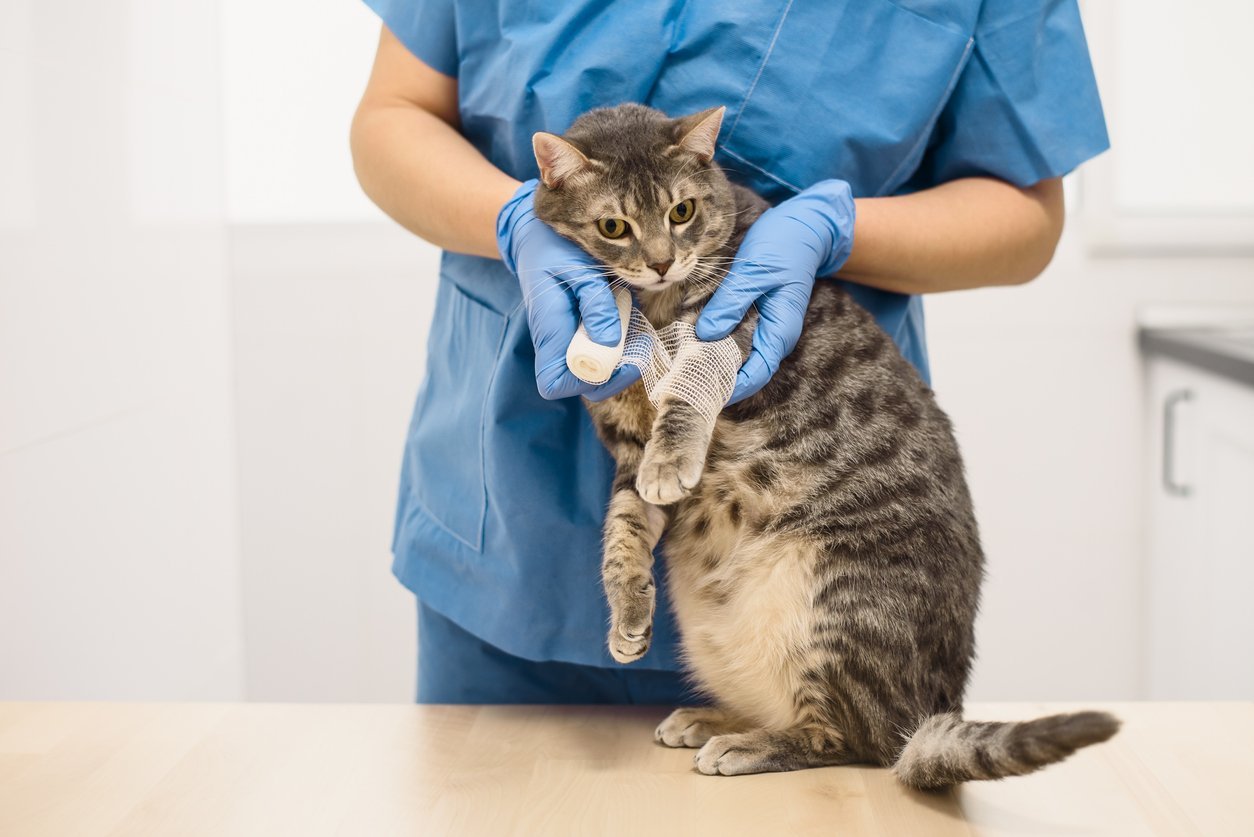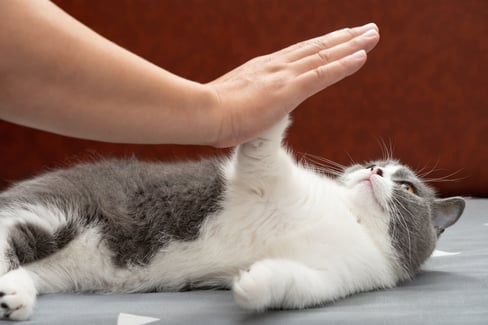Table of Contents
You hear a sharp, “meow!” from the other room. You rush to the scene and discover that your kitty has taken a tumble, stepped on something sharp, climbed onto a stove burner or any number of other common household hazard scenarios.
If you’re here, it’s likely your cat has a swollen paw from an incident like we just described and you’re trying to prevent any further cat pain.
Since our kitties love to get into precarious situations, we need to know how to best protect them from a painful situation like a swollen cat paw, and in this post, we’re going to cover just that.
That way, you’ll be purr-fectly prepared for any perils awaiting your kitty, even if it’s just inside your own home!
Cat Paw Swollen Symptoms
When it comes to cats with swollen paw symptoms, other than the obvious — your kitty’s paw will be irritated and inflamed — there are other symptoms to be aware of.
Depending on the cause of your kitty’s malaise, you may see the following swollen cat paw symptoms:
- Reduced appetite
- Frequent licking or biting of the paws
- Limping or lameness
- Reduced mobility and activity
- Paw discharge accompanied by a foul odour
- Paws that are hot to the touch
If you spot any of these symptoms, it’s time to call your vet. If you catch your kitty in the midst of an injury like if you see them fall from a height, or get into a fight with another cat, it’s also best to call your vet to get advice on what to do next.
What Causes Cat Swollen Paw?
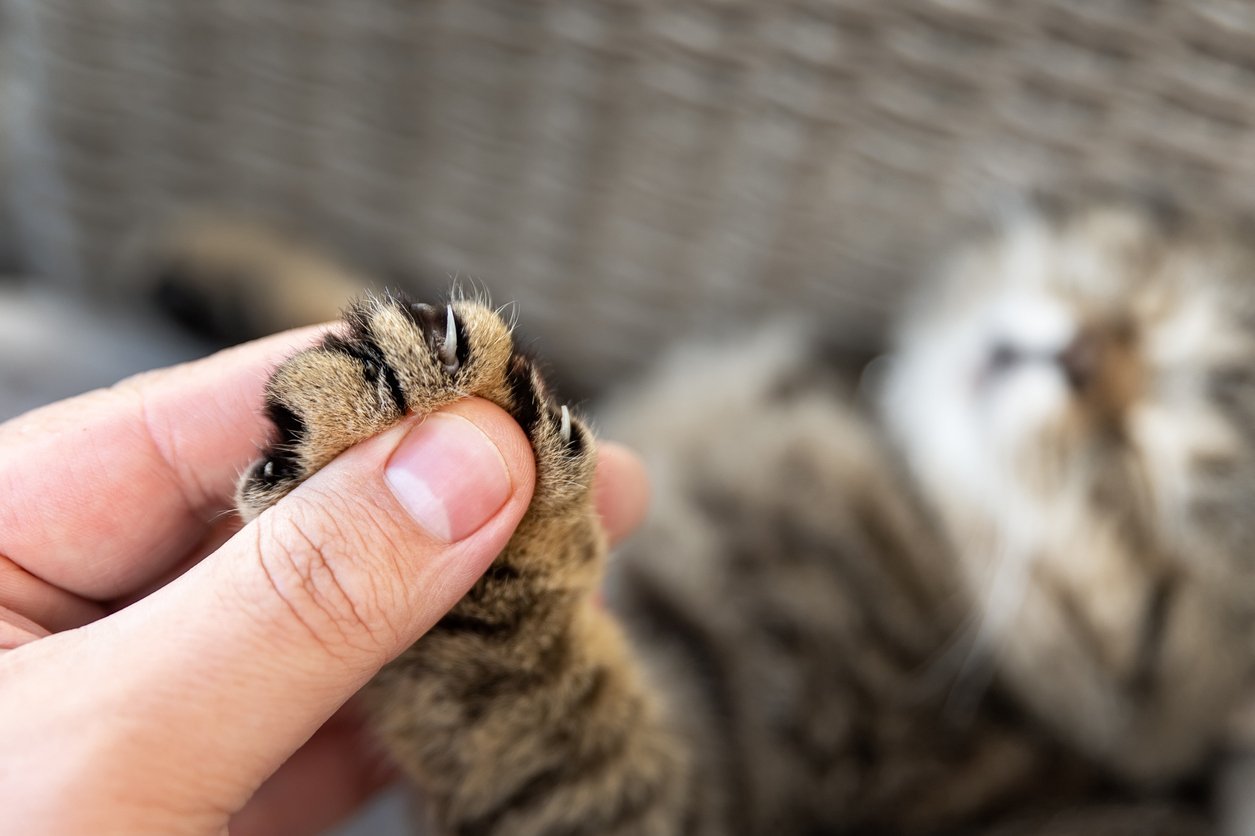
Curious cats can get into a lot of trouble, leading to many potential causes of swollen cat paws. What’s important to remember is that no matter what the cause of your swollen cat paw is, you should consult with your veterinarian on what to do and how to handle it.
Common major causes for cat swollen paws include:
- Environmental factors (allergies)
- Trauma to the paw
- Nail and grooming issues
- Infections (both bacterial and fungal)
Let’s get more specific with each of these categories.
Cause #1: Allergies
Allergies. They’re the worst! Even our feline friends can’t get away from those pesky symptoms.
Cats with allergies can be sensitive to a lot of things they breathe in, eat, or touch. Your kitty may exhibit various symptoms when attempting to process and rid themselves of these irritants. One of these symptoms can be swollen paws.
Some symptoms that often go hand in hand with allergic reactions in cats include:
- Wheezing, snoring, sneezing, and coughing
- Itchy, watery eyes
- Acute ear infections
- Licking (grooming) excessively
- Dry or red skin
- Itching
- Diarrhea or vomiting
If a cat steps on, or otherwise encounters a substance they are allergic to, they may begin to experience swollen paws in response.
Common irritants that can lead to swollen cat paws include:
- Pollen
- Grass
- Fleas
- Fungi
- Mold
- Dust
- Household cleaning supplies
- Food allergies
Ease allergies by avoiding unsupervised outdoor activities and keeping your kitty up to date on shots and vet visits. You may also be able to feed your cat corticosteroids to help with symptoms of cat allergies, but only as directed by your vet. That way, you can keep your cat’s health in tip-top shape!
Cause #2: Cuts and Abrasions
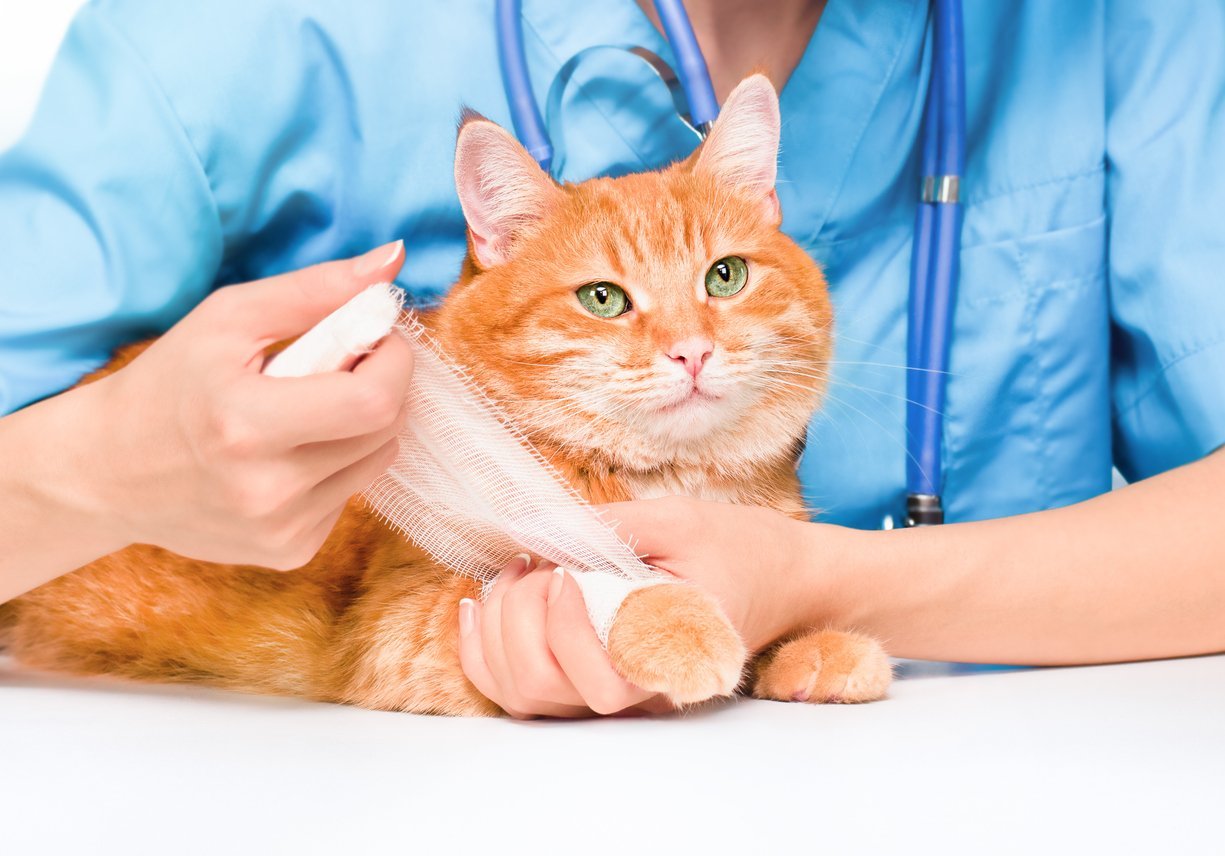
Swollen cat paws can be caused by cuts, abrasions, and tears that kitties often sustain when playing and running around the home. Whether it is outside or inside, common household elements can become hazards for your kitty.
Indoors, common causes of an abrasion that leads to a swollen paw can be avoided by:
- Leaving breakables behind cabinet doors. Your kitty can’t knock things off a shelf and step in broken glass or pottery shards that way.
- Keeping knives and other sharp objects out of paw reach. Avoid leaving sharp objects laying on the counters and surfaces where your cat likes to walk.
- Put away DIY and craft supplies. Things like needles and thread, as well as other tools used for home improvement that can be sharp, may be appealing to investigate for your cat. Make sure you put them away when you’re done using them.
- When you or another human in the house breaks a glass, be sure to clean it up very thoroughly to avoid your kitty stepping into a shard later.
- Skipping playtime on slippery surfaces with your cat, like linoleum or hardwood floors, as they can easily slip or slide and injure themselves.
Of course, outdoor cats are at greater risk of encountering sharp hazards that could harm their paw pads and cause trauma simply because you don’t know exactly where they are going and what they are encountering.
Sources of trauma that can lead to swollen cat paws for outdoor cats can include:
- Construction debris
- Road salt or other chemical substances causing them irritation
- Broken glass
- Metal objects (like pop cans)
- Fights with other cats
- Rough surfaces (like asphalt)
- Sharp edges (fences, signs)
In order to keep your outdoor kitty safe, avoid letting them wander in unsupervised areas and try to keep them confined to the backyard or catio. If you haven’t checked in a while, look for trash or other debris that could have blown into your yard to give them the best chance of avoiding a serious cut to their paws.
Cause #3: Nail Problems
Your cat keeps their nails naturally in check by clawing at toys, scratching posts, and other kitty furniture designed for this exact reason. When your cat isn’t able to maintain a comfortable nail length, problems can begin to arise. Overgrown nails are prone to catching, twisting, and tearing on surfaces and objects around the home. This can lead to your cat’s nails becoming damaged, causing their poor paw pad an awful lot of pain. Ingrown nails, another consequence of poor nail care, cause pain for your cat as the nails curl and grow back into the paw pad.
Other nail-related problems can arise when too much nail has been cut. Often, we trim our cat’s nails in order to avoid the problems associated with overgrowth. But sometimes, we trim just a little too much.
Be careful not to get too close to the pink part of the cat’s nail called “the quick,” where blood vessels and nerve endings are located. The quick is very sensitive, just like the pink part of a human fingernail. Cutting into this area will likely result in bleeding and pain. When that happens, you can invite infection into the area and that will likely lead to a swollen cat paw before you know it.
Cause #4: Bacterial and Fungal Infections
Another way you may end up with a swollen cat paw is thanks to a nasty assailant known as infection. Both bacterial and fungal infections can plague your kitty with a painful swollen cat paw.
Bacterial infections are a proliferation of a harmful strain of bacteria on or inside your cat’s body. Bacteria can infect any area of the body and cause your cat to feel a laundry list of uncomfortable symptoms, including a swollen paw.
Bacterial infections are often transmitted through:
- Water
- Broken skin
- Animal-to-animal transmission
- Virally, from infections such as FIV
Fungal infections on the other hand (or should we say paw) are slightly different. Your cat can become infected in three ways. It can be ingested, inhaled, or absorbed through the skin. A cat can come into contact with fungi in a variety of ways as it can live in many different environments. This is especially true for outdoor kitties exploring the soil, where many fungi exist. They can inhale or dig up the pathogen, or step in it, leading to a painful infection.
Like in humans, fungal infections are fairly common and highly treatable. Staying on top of regular vet visits, including vaccinations, can help protect your kitty from infections like these.
Cause #5: General Trauma
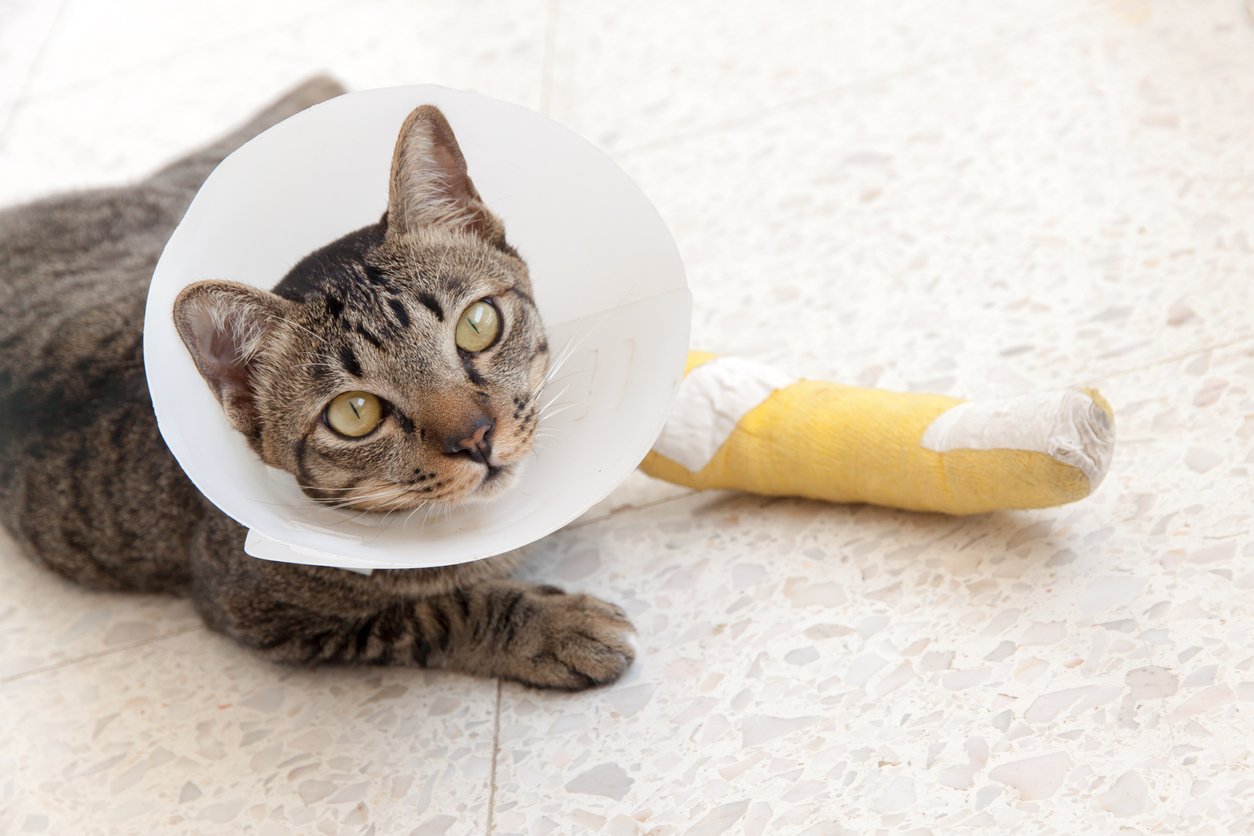
Another reason why you might be saying to yourself, “my cat has a swollen paw, now what?”
We have mentioned that cats are adventurous little creatures and that they can find themselves in sticky situations more often than not. Outdoor cats especially may experience a cat paw swollen after fight with another cat or animal. They also may experience a swollen cat paw from exploring new territory, or from encountering insects like a cat paw swollen from bee sting.
That can lead to trauma that causes a swollen paw, including:
- Burns
- Stings or bites
- Blisters
- Sprains
- Fractures
Everything from common household appliances like the stove to the wall shelves can end up being a painful encounter for your cat. Avoid preventable injuries by providing your cat with plenty of enrichment and their own safe structures to climb on, like cat trees and towers. That way, they are less likely to fall from great heights or get bored and decide to become curious in the wrong place at the wrong time.
Cause # 6: After Medical Care
Believe it or not, your kitty can suffer from a swollen cat paw after they receive medical care. It’s not uncommon for people to return home from a trip to the vet only to notice a swollen cat paw.
Here are three reasons why a cat paw is swollen after medical care:
- A bandage or dressing is too tight
- After receiving IV fluids
- Reaction to a vaccine or shot
A cat paw swollen from bandage or dressing is usually because it is wrapped too tight. Swelling above or below the bandage indicates it is wrapped too tight. You may also notice your cat licking or chewing at the bandage.
If the licking and chewing persist after you have rewrapped the bandage, you should ask your vet to provide an e-collar, as licking and moistening the bandage can worsen the injury. Ingesting the bandage material can lead to intestinal obstruction and, in some cases, require surgery for removal.
It is also common to notice a cat paw swollen after IV medications or fluids or having their blood drawn. IV (intravenous) injections or catheters are commonly placed in the cephalic vein above the wrist or the saphenous vein above the tarsus. A bandage is wrapped around the injection site to apply pressure and allow it to clot. If you don’t remove the bandage within four hours of bringing them home, you risk venous occlusion.
Venous occlusion can result in:
- Blocking the blood from traveling back to the upper body through the vein.
- Severe swelling of the cat paw below the injection site
- Loss of skin, tendons, pads, or nails
A swollen cat paw may be caused by a reaction to a vaccine or shot. Localized swelling around the vaccination site is considered a mild and non-serious side effect of routine vaccinations. Since most vaccinations are administered in the cat’s wrist and arm, the reaction commonly presents as lumps and bumps and a swollen cat paw. If a cat paw is swollen from a vaccine, the swelling and any lumps should disappear within a week.
Cat Swollen Paw No Pain: What to Do?
When you notice a cat swollen paw no pain, it doesn’t always mean that there is not a problem, or the problem will go away on its own.
One example of a condition with a swollen cat paw no pain is feline plasma cell pododermatitis, aka. “pillow paw”. Pododermatitis is characterized by severe inflammation causing a cat swollen pad on paw. If left untreated, this condition can become very painful, causing lameness and bleeding, even affecting your cat’s eating and sleeping habits.
If you notice a cat swollen paw that is mushy in appearance or blueish purple in colour, you should contact your vet about possible pododermatitis.
Examples of what causes a swollen cat paw resulting in pillow paw include:
- Immune disorders
- Reaction to cat litter
- Feline Immunodeficiency virus
- Feline infectious peritonitis (FIP)
- Infections (bacterial, fungal, or parasitic)
- Allergies
To treat these infections, viruses or allergies, your veterinarian will likely prescribe antibiotics or steroids, or possibly surgery.
Cat Paw Injury Swollen: How to Tell?
Swollen cat paws and cat paw injuries can be hard to tell; all that fur covering those tiny paws makes it harder to physically examine compared to bruising or swelling on ourselves. The best indicator to tell if your cat’s paw is swollen is to examine its symptoms and behaviour.
Signs of a cat paw injury swollen include:
- Bleeding or redness
- Cat paw pads peeling swollen
- Cat limping or refusing to use the paw
- Fluid discharge
- Excessive licking of injured paw
- Meowing when the injured paw is touched
When examining a swollen cat paw or cat paw injury, it helps to know the terminology and description of the parts of the cat paw.
The chart below identifies the parts of the cat paw.
|
Cat Paw Part |
Description |
|
Carpal bones |
|
|
Metacarpal bones |
|
|
Phalanges |
|
|
Carpal pad |
|
|
Metacarpal pad |
|
|
Metatarsal pad |
|
|
Digital pads |
|
|
Dew claw |
|
How to Prevent Swollen Paw on Cat
When a cat paw is swollen, it’s no joke. You’ve heard all about how this painful situation can happen in the first place, and now it’s important to make sure we can do our very best to prevent this from happening at all.
Just remember, cats are curious, sneaky, and very good at climbing. Sometimes, we can’t prevent these injuries, but it’s important to do our best to give all kitties a safe home environment.
Feed Joint Supplements
A tumble from a height is no joke, even for a creature like your cat who “always lands on their feet”.
And while this is often thought to be accurate, cats don’t always have a smooth landing. Sometimes, a fall can lead to severe injuries, like a cat sprained leg or a fracture in the wrist, and a sign of both of these injuries may be a swollen paw.
Adding supplements to your cat's diet is a helpful preventative measure. A good cat supplement will strengthen your cat's joints and soft tissues, better preparing them to heal from potential paw trauma. It can also help reduce the symptoms of arthritis for older cats who still like to get adventurous in their old age.
At Integricare, we understand how vital it is for our pets to be healthy now and as they age. That’s why we’ve created a premium, all-natural supplement perfect for keeping your cat’s body strong.
TRI-ACTA doesn’t just help keep their bodies strong and reduce pain in cat swollen paws, but it also:
- Provides collagen and connective tissue maintenance
- Boosts cartilage regeneration
- Enhances mobility
- Assists in reducing inflammation
By better preparing your cat for injuries before they happen, you can reduce the healing time after a particularly bad fall.
TRI-ACTA for Pets
A proactive approach for developing and younger adult pets to maintain optimal joint health mobility, minimize inflammation and fend off age-related ailments.
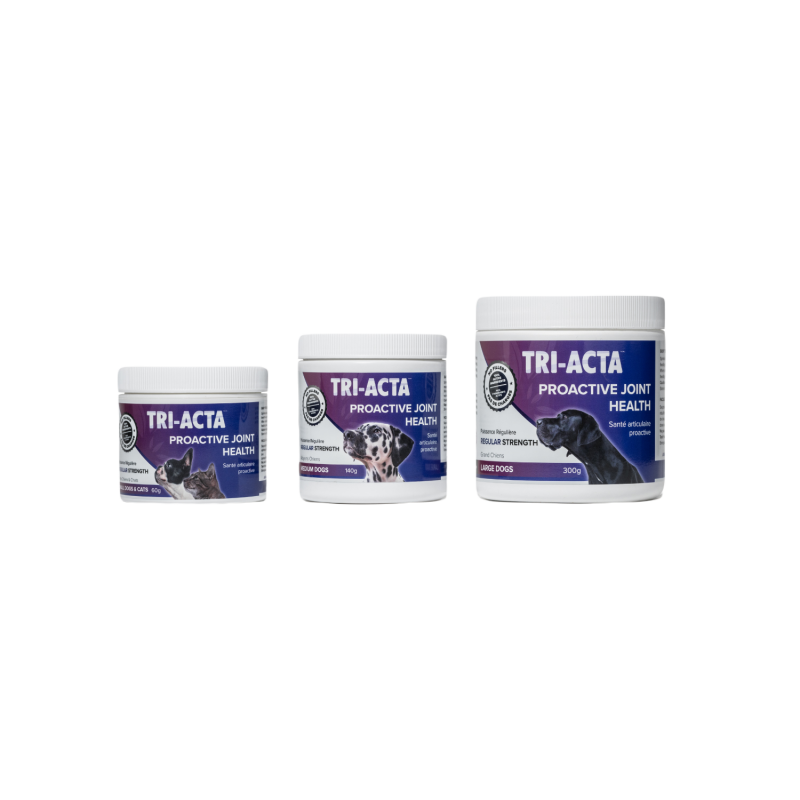
Keep Nail Care in Check
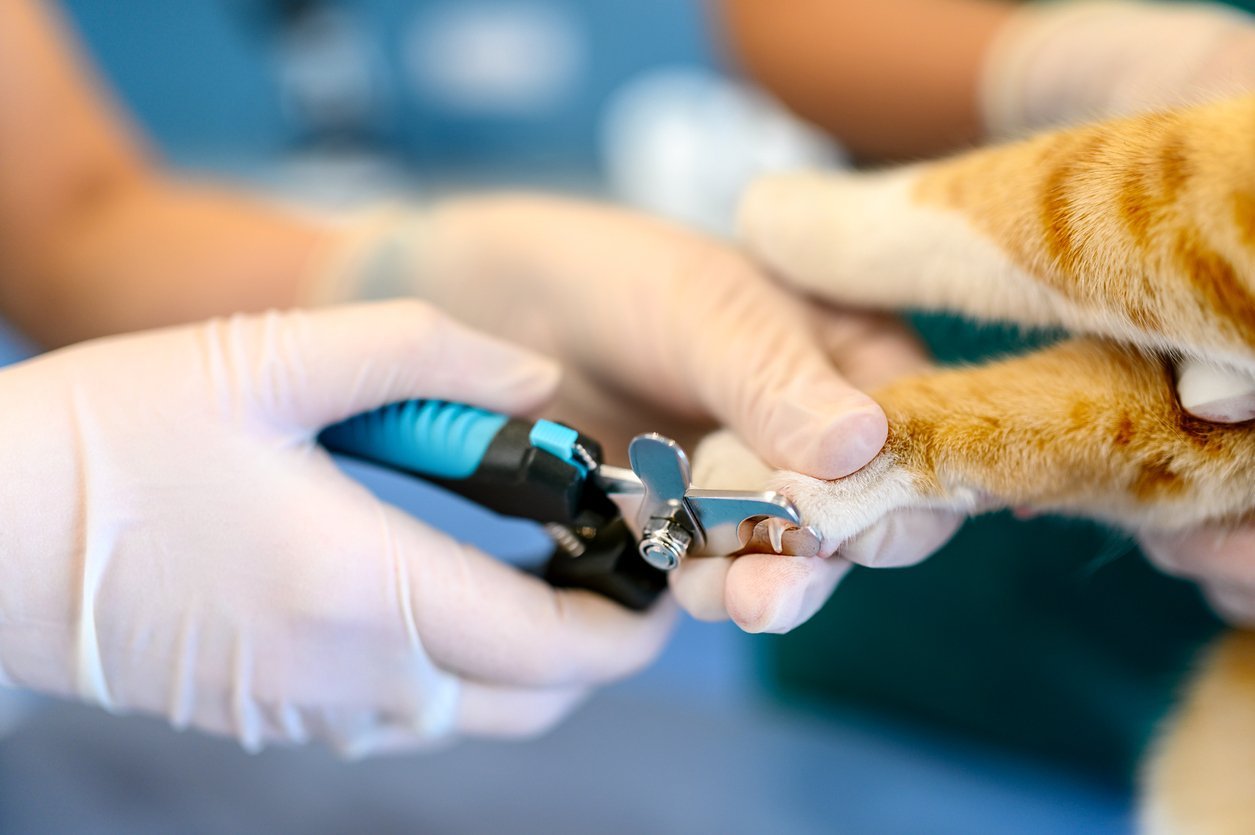
You know the outcomes for overlong nails in cats. Ingrowns. Catching. Breaking. Not good for your cat, and not good for you either.
Common infections, damage to the nail bed, and other injuries related to their claws can be major causes of cat swollen paws. That’s why it’s important to care for their nails regularly and carefully.
Keep on top of nail trimming every one and a half to two weeks, and give your kitty some natural nail filing opportunities through scratching posts and toys. If you’re not sure how to handle the grooming process, you can always bring your cat to a professional groomer and ensure their nails are well taken care of by leaving it to the pros.
Another word of caution — declawing can sound like an easy way to skip nail care, but it can actually cause serious issues and lead to swollen cat paws. When claws are removed from a cat’s foot, the way its foot meets the ground is altered, causing them pain similar to what they would feel wearing uncomfortable shoes. In addition, improperly removed claws can recur, as can nerve damage and bone spurs. The best choice to avoid swollen cat paws caused by this procedure is to avoid it altogether.
Play Safe
It’s not uncommon for cats to be adventurers. You know it, and we know it, too. Although this may be fun for them, it can be dangerous if they end up knocking something over. There should be enough spots around your house where your cat can jump around safely without getting hurt. By doing so, they can safely release their energy and get curious.
Allow your cat to explore vertically in the home. Your cat will enjoy shelves, climbing poles, cat trees, and other toys designed for exploring heights. Some toy mice and birds will entice their hunter instincts and keep them busy — and safe. Be sure to play with your feline friend for at least 20 minutes, but ideally more, a day and switch up your routines to keep these clever kitties satisfied, and out of trouble. Not only is it good for kicking boredom, and saving your furniture from a scratch attack, but playing with your cat helps relieve their stress and improve the bond you share with your kitty.
Go Indoors
Did you know that indoor cats live up to three times longer than outdoor cats? Unfortunately, it’s true, and as much as your kitty loves to frolic in the sun, it’s not always the safest place for them.
From the fungi in the soil to bacteria in other animals’ waste, to dangerous heights and loose trash, the outdoors is a risky place, especially if you’re trying to avoid a swollen paw on a cat. Instead, focus on enriching your favourite feline’s indoor space and adding daily playtime to your schedule.
If your kitty must venture out, there are a few things you can do to avoid the worst outcomes, like when a cat has swollen paw:
- Bring them inside at nighttime
- Install cat fences or create an enclosed outdoor area like a Catio
- Keep up to date with vet visits and vaccines
- Microchip your cat so if they turn up at a vet, they can easily get in touch
- Monitor your cat’s regular hang out spots for debris and dangers
How to Treat a Swollen Cat Paw
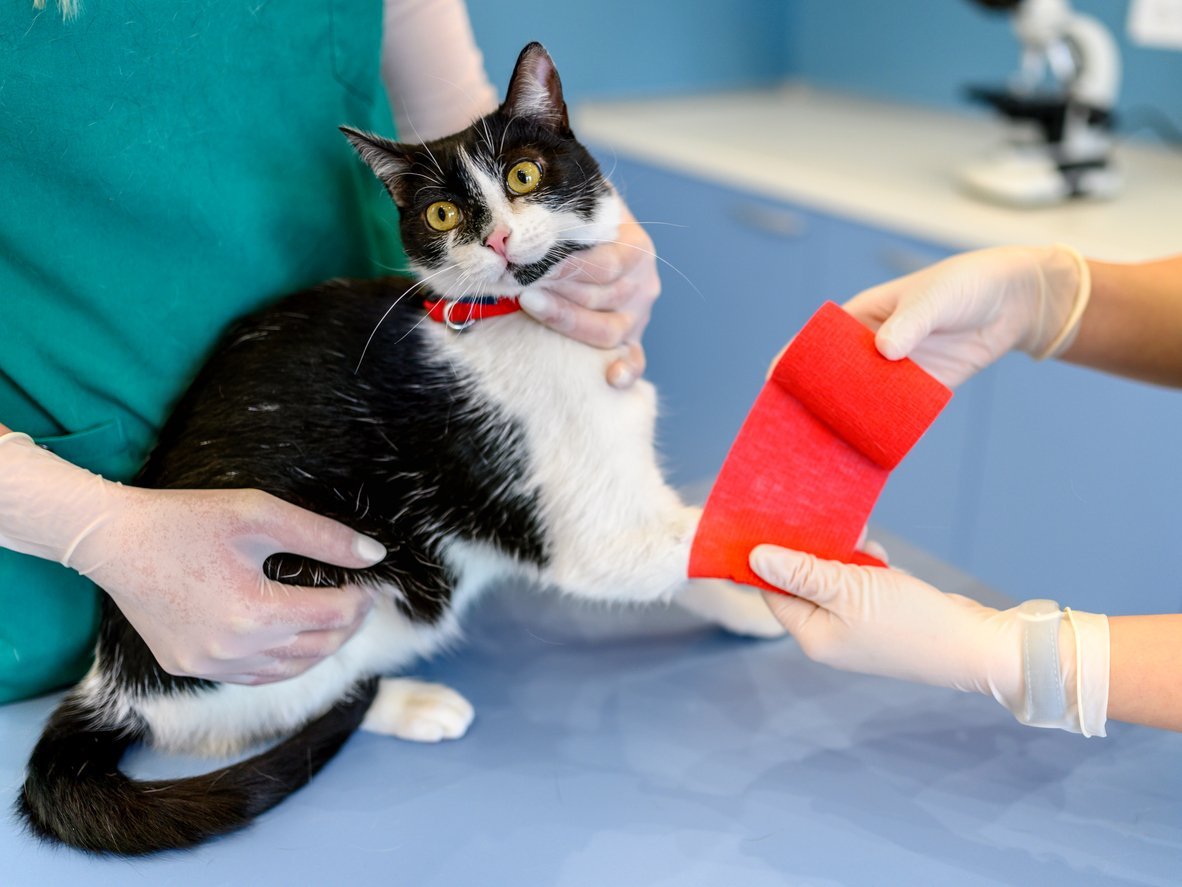
When you experience a cat paw red, swollen and painful for your kitty, you want to do something and do something fast.
Knowing which direction to go with for a swollen cat paw treatment is just one thing you need to have in your back pocket as a cat parent. Another is if you’re unsure of what to do, or what is going on with your cat, call your veterinarian. They can always give you the best advice for your unique situation.
How to Treat Cat Swollen Paw Home Remedy
When your cat has a swollen paw, there is often an underlying, internal cause. But how do you address a problem from the inside? The answer — is supplements for cats.
The right supplement can help heal your cat’s joints now and make them stronger in the future.
When trying to find the right supplement for your cat, there are a few things to keep in mind. First, you should try to find a supplement that contains as few fillers as possible. Additionally, a supplement that has been third-party tested for quality is a great way to ensure a supplement’s ingredients are top-notch.
When it comes to ingredients, you should learn how to read a supplement label before you hit the store, but the key ingredients to look for to soothe swollen cat paws are:
- Glucosamine
- Chondroitin
- MSM
- Hyaluronic Acid
Integricare’s TRI-ACTA satisfies all of these requirements, along with the ease of serving in powder form. Even the pickiest cats will enjoy relief from a sore cat paw faster than you can say ‘meow’!
TRI-ACTA H.A. for Pets
Our maximum strength formula is optimally designed to accelerate the formation of cartilage, minimize inflammation, expedite the healing process, and improve joint conditions.

Medications
Sometimes, the best-swollen cat paw treatment is medication.
Swollen cat paws can be caused by some serious and severe situations, while other times, it may be a mild situation that leads them to trauma. And as much as we’d like to think we can take care of our kitties with home remedies, sometimes it’s best to leave it to your vet to do the remedying.
From more severe falls where to insect bites where pain management and medication may be needed for a swollen cat paw, your vet may prescribe medication as outlined in the table below.
| Swollen Paw Cat Cause | Common Medications |
| Bacterial Infection |
|
| Fungal Infection |
|
| Allergic Reaction |
|
| Trauma (Fracture, Sprain) |
|
Never feed your cat human medications, over-the-counter medication or human ointments. They do not process certain ingredients the same way we do, and can often do more harm than good.
Surgery
No matter the cause, the good news is that most cat surgeries are pretty low-risk. Pre and post-operative instructions will also be shared with you by your vet, but a general rule of thumb is to limit your cat’s movement and ensure you keep their wound clean.
A joint supplement with the addition of hyaluronic acid like TRI-ACTA H.A. can help recovery times improve as well. It works alongside a vet’s recovery plan to get your cat back on its paws again!
Q&A
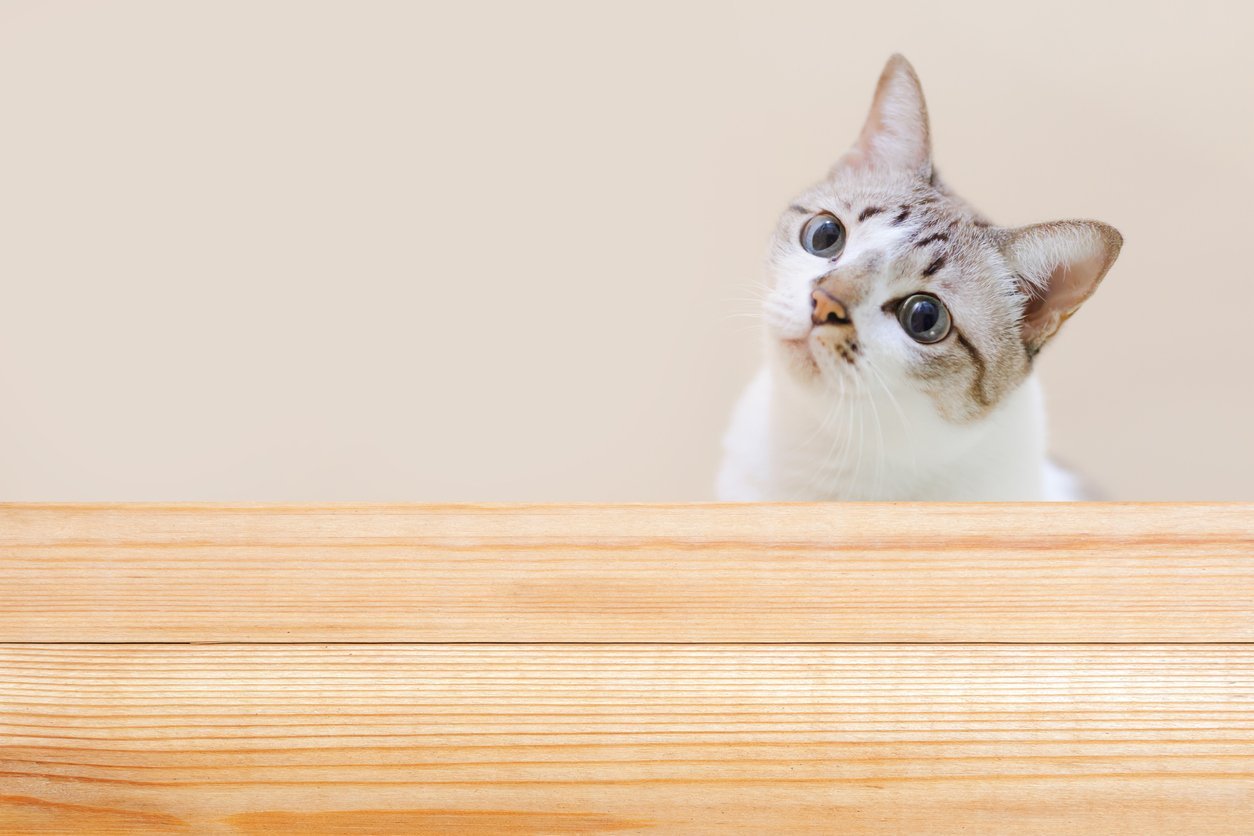
What Can I Give My Cat For a Swollen Paw?
For a cat swollen paw home remedy, feline first aid is essential. Approach a cat with a swollen paw as follows:
- Assess the area for any additional threats and the potential source of danger. Remain calm.
- Approach your cat and gently assess their paw. Wrapping them in a blanket or towel can help lightly restrain them, and prevent further injury, especially for broken or sprained limbs and paws.
- Look for any debris in the paw, and if their swollen cat paw is bleeding, apply pressure and a dressing.
- Call your vet once your cat is stabilized and not in danger of hurting themselves any further for further first aid advice. They may suggest you monitor symptoms or come right in.
- Once your vet has checked your kitty out, they will instruct you on how to care for their wound or the symptoms of a swollen cat paw. One thing that can improve symptoms they are experiencing as a result of their injury is feeding a maximum strength joint supplement like TRI-ACTA H.A. to reduce swelling, inflammation, and pain.
Is Swollen Cat Paw No Pain Possible?
Yes, it is possible to have a cat paw swollen, no pain. You may see your cat climbing around minutes after taking a serious tumble, or you may not even see they have hurt themselves until blood appears. Cats are resilient little things, but you should take notice if symptoms accompanying a swollen cat paw appear, such as bleeding or cat limping.
Help Prevent Swollen Cat Paws
In order to prevent swollen cat paws, you know you need to protect them as best you can from the hazards in the world around them.
And the best way to not only prevent but improve the symptoms of a swollen cat paw? A joint supplement like Integricare’s TRI-ACTA for pets. Offering the highest quality ingredients in a small, therapeutic dose, TRI-ACTA and the maximum strength TRI-ACTA H.A. strengthen your cat’s joints and soft tissues, preparing them for the adventurous, albeit risky lives our cats love to live.
Now that’s a purr-fectly good solution we can all appreciate.
TRI-ACTA H.A. for Pets
Our maximum strength formula is optimally designed to accelerate the formation of cartilage, minimize inflammation, expedite the healing process, and improve joint conditions.

Newsletter Signup
Subscribe to our newsletter to receive the latest news and exclusive offers.
.jpg?height=2000&name=Cliick_Integricare-DISPLAY-REVISEDV2%20(1).jpg)
Proactive & Therapeutic Joint Supplements
When given daily, Integricare joint supplements recover bone and joint injuries faster and help prevent mobility injuries from happening in the first place.

